 Download this article in magazine layout
Download this article in magazine layout
- Share this article
- Subscribe to our newsletter
A sector in transition
One of the main messages of the COP 28 UAE Declaration on Sustainable Agriculture, Resilient Food Systems, and Climate Action in late 2023 was that to fully achieve the long-term goals of the Paris Agreement, agriculture and food systems have to be included if we are to meet the Sustainable Development Goals (SDGs). We need to use land more sustainably, minimise negative impacts on the environment and seek for opportunities to restore lands that have lost nutrients and biodiversity. At the same time, food systems have to provide all people with access to a more nutritious diet. Taken together, this is a big ask of future food systems, given the growing demand for food from rising populations and a warming, more variable climate. The livestock sector is an important contributor to both the challenges and the solutions. On the one hand, it is a major user of land and emitter of greenhouse gases, but on the other, it provides food with high quality protein and high levels of micronutrients, as well as incomes and livelihoods for hundreds of millions of people, particularly in lower-income countries.
Livestock production has been growing rapidly in response to increasing demand. The livestock sector now has considerable impacts on global biogeochemical cycles and is a substantial user of water as well as causing losses in biodiversity. Reducing the environmental footprint of livestock is vital if it is to contribute to sustainable food systems in the future. The sector is highly dynamic in relation to its use of natural resources and the trade between countries and the synergies and trade-offs associated with the changing nature of the demand and supply of animal food from cattle, sheep, goats, pigs and poultry.
Trends in livestock product consumption and trade
Changes in consumption of livestock products from 1990 to 2015 for the regions of the world and selected countries are shown in the Figure below. These trends have continued since; the last 35 years have seen an increase of about 35 per cent in per capita demand for meat across all regions, driven by large increases in demand for poultry and pork. Global demand for beef and mutton, in contrast, has barely changed since 1990, with declines in beef demand in high-income countries and Latin America (excluding Brazil) and large increases in China, Brazil, and Western Asia and North Africa. These regional patterns for beef apply to mutton, too. Per capita demand for poultry meat has increased in all regions, with small increases in East Africa and the USA and a near doubling in other regions. Demand for pork is regionally variable, with substantial increases in China, Southeast Asia, South America, and Australia. In lower-income countries, increased meat demand is mostly from pigs and poultry. Higher-income countries have seen substantial substitution of beef and mutton with pork and poultry. Demand for dairy products is growing at a similar rate to pork, with most regions seeing increasing demand.
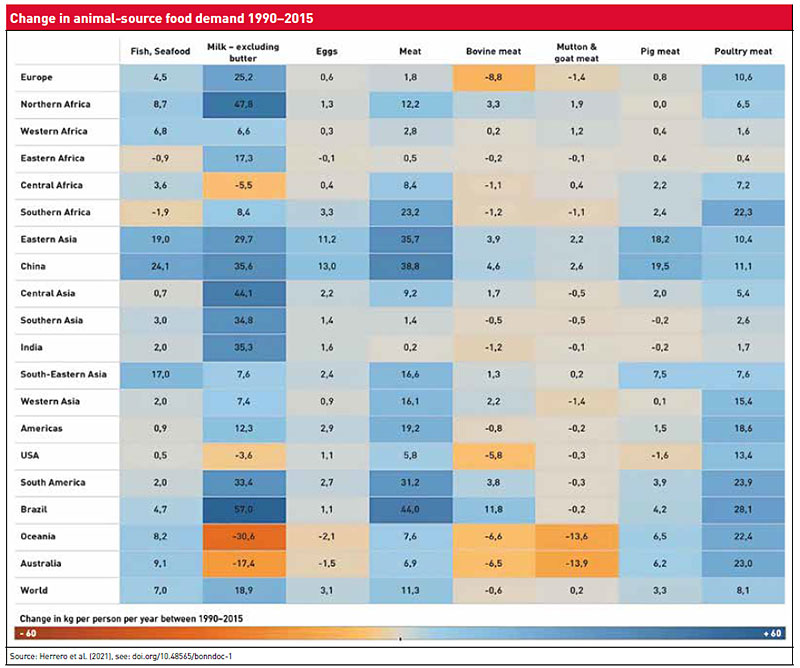
The increase in consumption in some countries has outstripped supply, leading to substantial increases in international trade in animal-source foods in recent decades. The value of exports has quintupled since 1990 to more than 300 billion US dollars (USD), representing almost 20 per cent of global production. Globally, meat dominates, accounting for about two thirds of the value of exports of livestock products. In Europe and Oceania, however, the value of the trade in dairy products and eggs is equivalent to that of meat. These two regions export 85 per cent of the global volume of these commodities. Europe (primarily pork), North and South America (beef, pork, and poultry) and Oceania (beef and mutton) produce more than 90 per cent of global meat exports.
Some of the trade in meat is within the same region of origin; for instance, a large proportion of the trade in pork in Europe and in mutton in East Asia and Pacific is intraregional. There are countries which dominate trade between continents, such as Brazil, Australia and USA, for example, regarding inter-regional bovine meat exports. With respect to volume, trade in livestock products is small compared with trade in animal feed. For example, trade in meat and processed meat account for less than ten per cent of the volume of trade in feed grains. The trade in feed is likely to intensify, to satisfy the rising demand for pork and poultry in importing regions. This may result in growing environmental impacts, which will need to be mitigated appropriately.
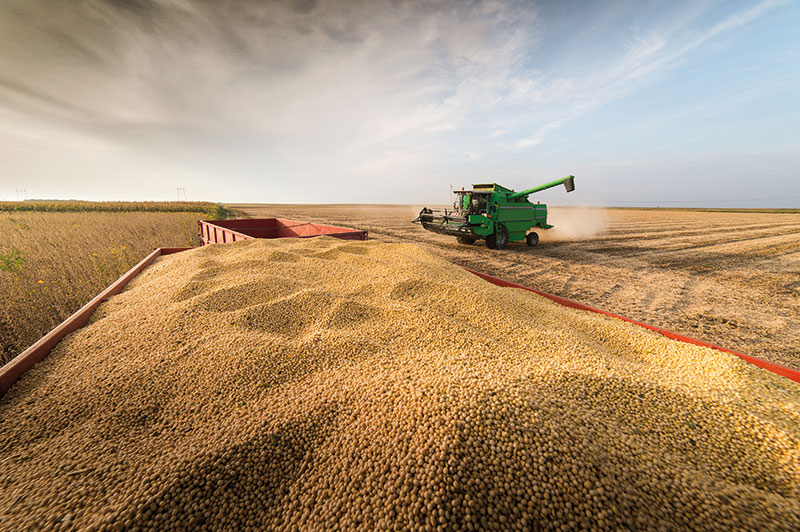
Soy harvest in Brazil. Trade in feed is likely to intensify, to satisfy the rising demand for pork and poultry in
importing regions. Photo: Fotokostic/ shutterstock.com
Trends in livestock production
Meat, milk and eggs are produced across most of the major agroecological zones of the world, with a wide range of intensification levels and resource use efficiencies. Livestock numbers closely track demand trajectories. Since 1990, the global tonnage of meat, milk and eggs produced has increased by slightly less than two per cent per year. This has occurred in all regions, with particularly high production increases in Africa and Asia. In higher-income regions, production has grown at a slower rate, and in Europe it has declined by more than 16 per cent since 1990. Across the commodities the fastest growth in production has been for poultry meat, which has more than tripled globally since 1990. Egg production has more than doubled, and pork and dairy production have both increased by 80 per cent. As for poultry, egg and pork production has risen across most regions. In lower-income regions, dairy production has grown at a similar rate to poultry, with much smaller growth rates in higher-income regions (and a decline in Europe). Europe’s beef and lamb production roughly halved from 1990 to 2022, whereas lower-income regions have seen substantial growth in small ruminant production.
Production efficiency gains have often been associated with intensification, which has occurred at different rates in different parts of the world. In some cases, this has led to a reduction in animal numbers. For instance, the USA produces 60 per cent more milk with 80 per cent fewer cows now than in the 1940s because of improvements in genetics, feeding and housing systems. Intensification (and expansion) of the livestock sector has occurred primarily in Latin America and Asia. By contrast, productivity in sub-Saharan Africa has remained essentially stagnant.
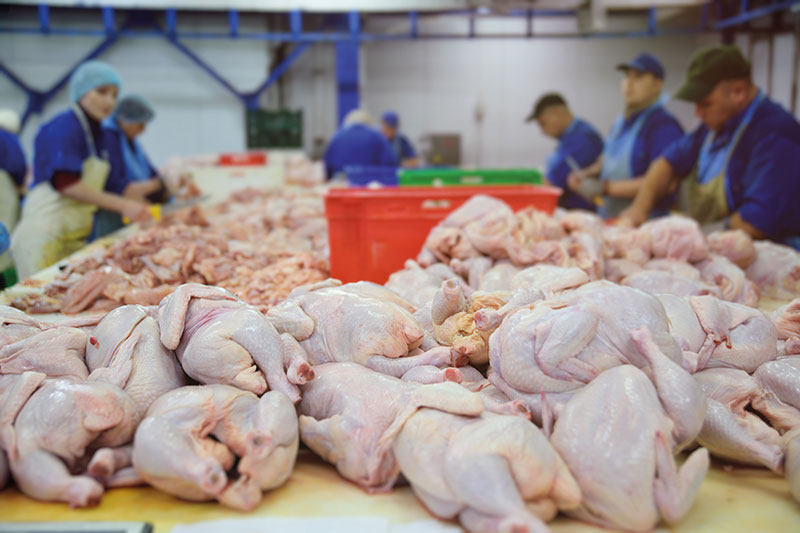
Demand for poultry has been the main global driver of increased meat consumption, with a near doubling of per capita consumption since 1990.
Photo: Evgeniy Kalinovskiy/ shutterstock.com
Different production systems, different dynamics
Most bovine milk and meat production takes place in mixed crop-livestock systems: 90 per cent of the milk and 80 per cent of the meat, with three times the number of animals, compared with grassland-based systems. Globally, observed increases in production have been driven mostly by increases in animal numbers. On average, livestock systems in temperate regions and higher-income countries have seen a four per cent per year decrease in animal numbers, while maintaining modest productivity increases of under one per cent per year. In arid and humid regions and many lower-income countries, by contrast, production increases have been driven almost entirely by increases in animal numbers. It is only the highland production systems of lower-income countries such as in Kenya and Ethiopia that have bucked this trend: increases in dairy productivity (28 %) outstripped the growth in animal numbers (9 %) between 2000 and 2011. Given the fact that the highland small-scale dairy production systems have been a major focus of research and extension efforts over the last 30 years or so, this is not that surprising.
Future role of smallholders in producing livestock products
Globally, livestock production is the mainstay of about 650 million people in lower- and middle-income countries. Livestock contribute 17–47 per cent of the value of agricultural production nationally and provide income to 68 per cent of lower- and middle-income country households, while also playing important cultural roles. Although there are wide regional variations, men are often responsible for cattle and cattle production, with women tending to be more active in raising small stock and in the processing and sale of products such as eggs and poultry. The contribution of livestock production to gender equity differs widely.
The future role of smallholders in producing livestock is highly uncertain and will depend on species and product. For dairy production, a sustainably intensified smallholder sector could help drive future production growth; there are still large yield gaps in these systems, and demand is growing. On the other hand, land fragmentation and feed scarcity may militate against continued viability of these systems in many lower-income countries.
The situation is different for beef. In the absence of increases in demand per capita, and with small farm output largely dependent on increased numbers of animals, size of operation will likely constrain production growth. Nevertheless, small-scale production in diversified farming systems may continue to be economically viable, even if not as the main source of income. For poultry and pigs, the distinction needs to be made between the rapidly growing industrial sector and the smallholder sector in which women are strongly represented. As economies grow, smallholder pig and poultry production may become less important as conditions become more favourable for the sector to industrialise.
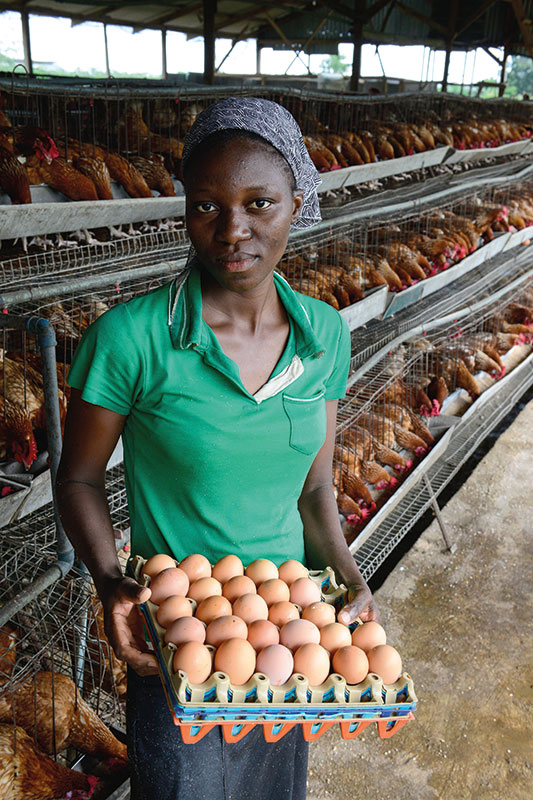
Egg production and sale tends to be in the hands of women.
Photo: Jörg Böthling
Livestock production, land use and the environment
Of the 3 billion hectares (ha) of land suitable for crop production, 1.5 billion ha is used to feed the world, and a third of that is used to produce feed for livestock. The remaining 1.5 billion ha is currently occupied mostly by forests, which play a fundamental role in biogeochemical cycles and provide many essential environmental services to humanity. Expansion of croplands into these areas needs to be avoided, hence the pursuit of agricultural intensification. Globally, total agricultural greenhouse gas emissions have risen, mostly due to increases in animal numbers and land-use change. Livestock account for the majority of greenhouse gas emissions from food systems through methane from enteric fermentation, CO2 from land use change, and nitrous oxide from manure management. Despite productivity improvements, the aggregate environmental impacts of livestock have continued to grow.
Livestock production affects biodiversity beneficially or detrimentally, depending on context: while livestock-induced land use conversion is a major cause of biodiversity loss, in extensive rangelands ruminant livestock can be an important means of biodiversity conservation and climate mitigation. Resource use varies widely by commodity type. Beef cattle tend to be the largest user of land and energy, followed by pork, poultry, eggs and milk. Resource use also varies by production system and setting. In many cases, livestock can be reared in lands of low opportunity cost, without competing with croplands or other land uses. Any intensive livestock production system has significant environmental impacts, especially for surrounding communities and waterways, and these have to be addressed.
What next for livestock product consumption?
The evolution of the global livestock sector over the last 30 years can be outlined in three storylines. First, demand for poultry has been the main global driver of increased meat consumption, with a near doubling of per capita consumption since 1990. Second, per capita dairy consumption in higher-income regions has stayed constant since 1990, production growth being driven by population growth. Lower-income regions have seen significant increases in dairy consumption, driven by both population growth and increased per capita consumption. Third, increases in global beef demand is largely down to China and Brazil, which account for nearly 93 per cent of the 11 million ton (Mt) increase in global beef demand.
Recent trends indicate that projected shifts to beef consumption as incomes rise may not be occurring in many countries. Indeed, in many higher-income countries, beef consumption is declining; this is particularly obvious in Europe, which saw a reduction of more than 10 Mt in beef demand since 1990. Excluding China and Brazil, per capita consumption in low- and middle-income countries has not increased appreciably. Reasons for this may include a combination of factors. In recent years, pork and poultry have been cheaper than beef by 50 per cent and 30 per cent, respectively. Increased messaging around the health and environmental impacts of beef consumption compared with white meats may also be having an increasing influence on consumer behaviour.
Contribution of sustainable livestock production to future food systems
Highly divergent future visions of the livestock sector can be found in the scientific literature. These include a business-much-as-usual world with continued (and considerable) increases in demand and consumption of livestock food, a world of techno-optimism that envisages widespread uptake of alternative protein in human diets with substantial declines in demand for livestock meat and milk, and a world that sees substantial declines in human consumption of livestock food and a move to more plant-based diets. Local, national, and regional contexts matter enormously, in terms of how the livestock sector may develop in different places in the future. Livestock development will be shaped by a host of factors, but some can be taken as effectively immutable to mid-century at least: the enormous economic and sociocultural value of livestock in many lower-income countries, the considerable disruption and loss of value to industrial and small-scale livestock systems alike that climate change will bring about in many places, and burgeoning demand for livestock products from growing and urbanising populations, particularly in Africa.
Different contexts will shape the nature of livestock development in different places, and livestock systems will evolve in many different ways in parallel. Changes in dietary preferences, alternative proteins for food (also see article "The untapped potential of protein diversification") and feed, practices that help to mitigate greenhouse gas emissions, sustainable intensification of livestock production revolving around the principles of circularity, adopting appropriate technological innovations, putting in place policies that can spur climate action in agriculture, repurposing subsidies that distort level playing fields for trade to incentivise climate action and move towards true cost accounting for the food system – these are some of the many ways in which livestock can contribute to sustainable food systems in the future. Implementing the most effective and desirable solutions will be essential for balancing stakeholders’ economic, social and environmental goals in different contexts. Underlying all this is improved understanding of the highly variable roles that livestock play. This is fundamental to implementing actions and policies that profoundly improve and, in many cases, may substantially change the ways in which we think about livestock.
Mario Herrero is a professor of sustainable food systems and global change and the director of Food Systems & Global Change at Cornell University, USA. His research focuses on increasing the sustainability of food systems for the benefit of humans and ecosystems. He continues to play senior roles in many global initiatives on food and the environment, in the areas of climate mitigation and adaptation, livestock systems transformation, sustainability metrics, and healthy and sustainable diets.
Mario Herrero is a professor of sustainable food systems and global change and the director of Food Systems & Global Change at Cornell University, USA. His research focuses on increasing the sustainability of food systems for the benefit of humans and ecosystems. He continues to play senior roles in many global initiatives on food and the environment, in the areas of climate mitigation and adaptation, livestock systems transformation, sustainability metrics, and healthy and sustainable diets.
Philip Thornton is based in Edinburgh, UK. He has worked for nearly 40 years in agricultural research for development in Latin America, sub-Saharan Africa and Asia. He is an Emeritus Fellow of the International Livestock Research Institute (ILRI), Nairobi, Kenya and a Visiting Professor in the Food Systems & Global Change group, Cornell University. Current activities revolve around food system innovation to increase resilience to climate change in smallholder agriculture.
Contact: p.thornton@cgiar.org


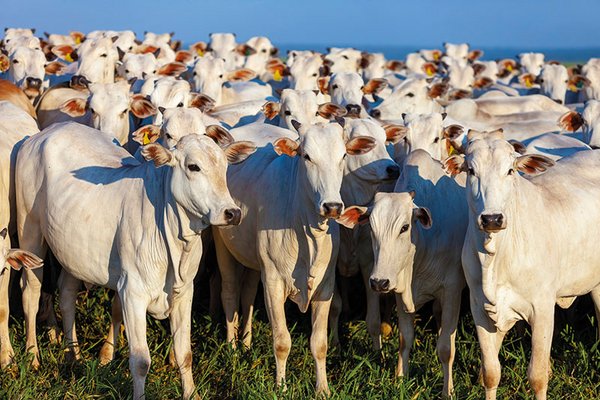
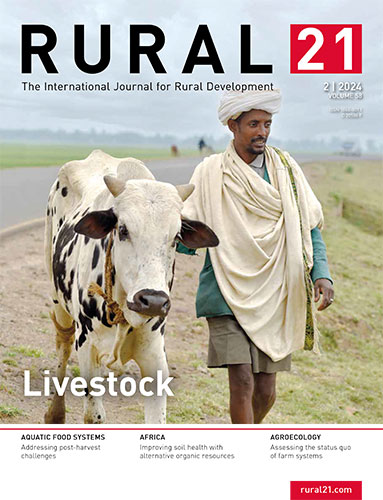

Add a comment
Be the First to Comment